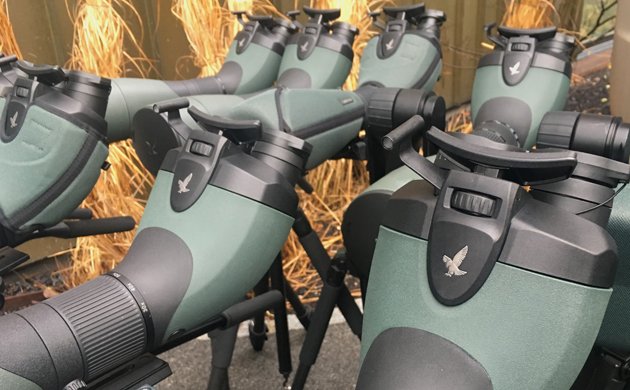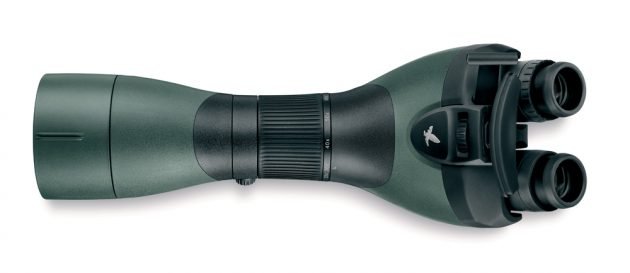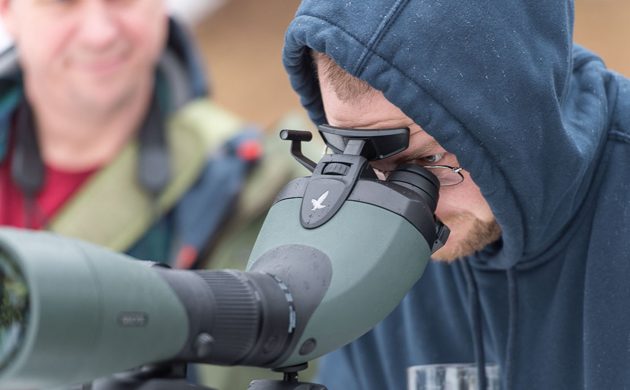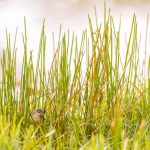
A little over a month ago I was hiking up a mountain path outside of Innsbruck, Austria, with birders from around the world. When we reached our destination we were greeted with glasses of champagne. And while the bubbly really hit the spot it seemed like it was a bit of overkill. The hike hadn’t seemed so difficult that we needed to celebrate having completed it with champagne. But then the presentation happened, a presentation by Dale Forbes, Head of Strategic Business Development for Swarovski Optik, for which he was introduced by Carina Schiestl-Swarovski, Chairwoman of the Executive Board of Swarovski Optik. By the end of it we birders – or at least me – were gobsmacked, gibbering, and giddy.
But let me step back for a moment. Have you ever used your spotting scope for an extended period of time? Perhaps on a lakewatch while ducks flew past and you hoped for a Long-tailed Jaeger? Or on a hawkwatch platform hoping to pick up and identify the Golden Eagle before anybody else? Maybe you like picking through flocks of gulls in a parking lot, hordes of shorebirds on a mudflat, or perhaps, like me, you stare out to sea hoping to finally get a Great Shearwater for your county list? Did you ever notice how quickly you start to feel eye fatigue? It’s tough to look through a scope for an extended period of time without feeling eye strain, losing concentration, and taking a break. And it could be that moment that you take your eye out of the scope that a rarity sneaks past.
This problem doesn’t happen with binoculars, does it? You can look through your binoculars all day long and never feel any eye strain. And the image you get through your binoculars, while not as magnified as it is through your scope, is superior in other ways. With two eyes you perceive depth of field, contrast, and movement much more quickly and easily. Humans have evolved with binocular vision and it is unnatural and unfortunate that our spotting scopes have, with a few unimpressive exceptions, left us stuck with an inferior monocular view. This is why when we have the choice, we use binoculars. You don’t see birders walking around with little monoculars. Given the choice, we want to fully use our sense of sight and to do so we need to use two eyes.
It’s been almost five years since the last innovative Swarovski spotting scope came out on the market, the modular STX and ATX spotting scopes. They have rightly taken their place as the premiere spotting scopes available to birders. What we birders didn’t realize at the time but in retrospect was obvious, is that Swarovski had a long term plan for the modular aspect of the STX and ATX. There was always going to be more than just a straight-through or angled eyepiece that you could swap out with three different objective lenses. What Swarovski brought us to Austria, and had us hike up a mountain to see, was the BTX, a binocular eyepiece that allows you to stare through a spotting scope all day long without experiencing eyestrain or, really, any major discomfort. And, because you use two eyes you get a much better look at whatever it is you are studying!
Image copyright and courtesy of Swarovski Optik
This revelation brings us back to when Dale was done with his presentation on that mountainside in Austria. We all filed outside where a bunch of the new BTX were out for us to play with. And play with them we did! Someone at Swarovski must have done something right because the persistent fog that had haunted us on our hike up the mountain parted temporarily and allowed us to focus on a Eurasian Bullfinch perched high on an evergreen. It was possibly the most oooed-and-aahed-over bullfinch ever. The bird positively popped into my eyes and like Alice in Wonderland I felt as if I was through the looking glass.
Some birders really couldn’t contain themselves when they saw the BTX.
Over the next couple of days as we got more familiar with the BTX and really got to understand its capabilities and limitations. Rather than try to construct a narrative around them I thought I would present them in simple list form. Some are related to my experience using the BTX and some are from the product specs. This is not an exhaustive list but it does hit most of the pertinent points.
PRO – Being able to use two eyes makes the birds (or other things you look at) appear more three-dimensional, like when you look at a magic eye puzzle and the image finally jumps out at you. This has to do both with depth perception being better with two eyes and with the fact that the light-gathering ability of two eyes is twenty to forty percent greater than just one eye.
CON – Switching to the BTX requires a longer learning curve than switching between monocular scopes. I kept finding myself approaching the scope from the side as if I was going to use one eye instead of walking right up to it to use both my eyes.
PRO – Contrast, even on foggy or rainy days, was much easier to discern. This will make finding distant birds easier, as well as picking out slight differences in plumage or soft-parts color. Using two eyes can boost contrast perception by up to forty percent compared to using one eye.
CON – Digiscoping with the BTX will be limited to using phones with adapters: there is no way to use an SLR or point-and-shoot. (That said, switching out an ATX or STX for the BTX is a quick and simple operation.)
PRO – Having binocular vision makes it easier to get smaller children to look through a scope successfully, no small thing for birding parents.
CON – Replacing the ATX or the STX for a BTX removes the ability to zoom the scope. The BTX has 30X magnification with the 65mm or 85mm objective, 35x magnification with the 95mm. This issue is partially dealt with by the ME 1.7mm extender, an optional accessory that can be quickly mounted between the objective and eyepiece modules and increases the magnification to 50X or 60X, depending on which objective you have.
PRO – The adjustable forehead rest makes extended sessions with the scope much more comfortable. And if you are sharing your BTX you can retract the rest so it is not in the way of someone with a fivehead.
PRO – The aiming aid is intuitive, well-designed, and useful to those of us who are accustomed to using straight-through scopes and are not used to an angled scope.
CON – The BTX is heavier than either the ATX or the STX. With the 85mm objective the ATX weighs four-and-a-quarter pounds. The BTX with the 85mm weighs five-and-a-half pounds.
PRO – It was much easier to track birds in flight with the BTX than I would have thought possible. Somehow having two eyes in the scope made it much simpler to track moving objects, even when watching dog-fighting Red Kites. (Which, by the way, was awesome.)
CON – Cost. High end glass is expensive. The BTX is essentially a fancy pair of binoculars attached to the objective lens of a scope. A BTX with the 95mm objective is going to be listed at $4748.
PRO – Modular! If you already own one of the modular scopes you can purchase just the BTX without the objective for the listed price of $2689.
PRO – The BTX is as adjustable as you would expect from Swarovski. You can adjust the interpupillary distance, twist eyecaps out for those without glasses, and there is a diopter just like on binoculars.
Me using a BTX in the rain. Image courtesy Swarovski Optik.
Obviously, there is a lot more to this marvelous new spotting scope than I packed into this post. (For example, I didn’t even touch on the new balance rail or Gimbal tripod head.) If you’re interested in more information I’d suggest keeping an eye on the Swarovski Optik website and Facebook page. The BTX will be available on 2 May.
To conclude, if you are used to using scopes for an extended period of time doing surveys, lakewatching, gulling, seawatching, shorebirding, or hawkwatching, you will want a BTX. If you have a hard time using one eye through a scope you will want a BTX. If you want the best possible look at a distant bird you will want a BTX. If you hardly use a scope at all you probably can live without one but why would you want to?
Alright, that last line was a bit over the top but if you get the chance to take a look through a BTX, like at the Biggest Week in American Birding where Swarovski should have some to show off, do so and see that I’m not being totally hyperbolic. Ever since the looks I got at Red-crested Pochards on Lake Constance through the BTX I’ve been slavering at the thought of getting my hands on one again. How else am I finally going to have the patience to stare at the ocean until I finally get my Great Shearwater in Queens?
…
Swarovski Optik flew me (and a bunch of other birders) to Austria to get an advance look at the BTX. I like to think I maintain my objectivity in such a situation but I probably have an implicit bias in favor of Swarovski after such treatment. Nonetheless, I did my best to present both the positives and the negatives of the BTX as I perceived them. Please check it out for yourself and see how you feel about it.
…
















Looks like it needs a lot of quarters.
This is a dream scope but too unaffordable